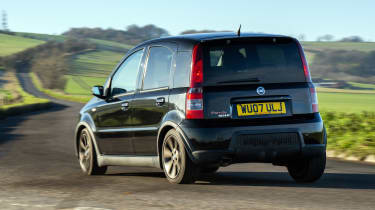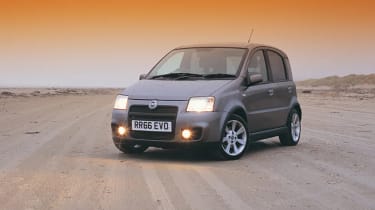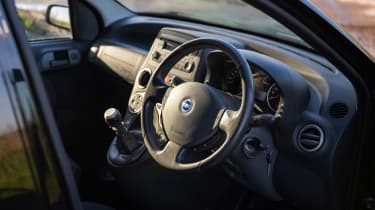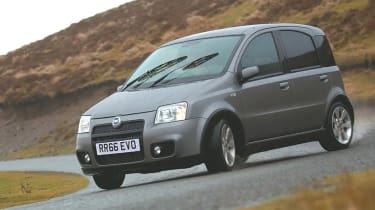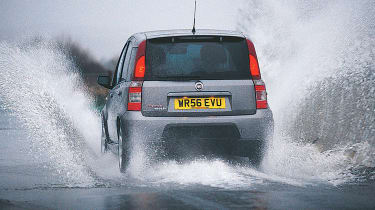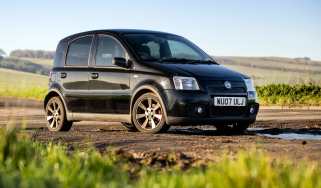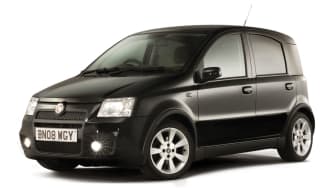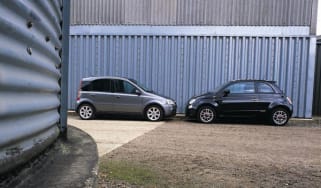Used Fiat Panda 100HP (2006 - 2010) review: a driver's supermini for under £3000
Almost two decades since its launch, the Fiat Panda 100HP is a truly bargainous tiddler that still delivers big smiles
Preceding Abarth’s 2007 revival by a year, the Panda 100HP was launched as Fiat’s most focused road car, sitting at the top of the Mk2 Panda range. A host of design changes, a dynamic overhaul and the adoption of the Punto’s 1.4-litre, overhead-cam, 16-valve ‘FIRE’ engine turned Fiat’s high-volume everyday offering into one of the most engaging superminis of its time.
The 100HP looks rather understated by today’s standards, but Fiat didn’t skimp on its makeover. New 15-inch wheels, a wider track and swollen arches gave it a stout, aggressive stance like nothing else in its class. At the front, a deeper grille upped the aggression, while at the rear a diffuser-esque insert in a new bumper had a similar effect. Fiat also made the decision to remove the Panda’s roof rails to create the illusion of a lower ride height, with a roof spoiler and tinted rear windows completing the exterior uplift. Just five colours were available to choose from – black, white, red, blue and grey – and customers could also opt for the Pandamonium pack, which added red brake calipers, red side stripes, darker alloys and silver door-mirror casings.
> Fiat Panda 100HP Fast Fleet test – living with a £2000 pocket rocket
More reviews
Outputs of 99bhp and 97lb ft seem even more modest now than they did 18 years ago, but a kerb weight of just 975kg means a useful power-to-weight figure of 103bhp per ton. The engine thrives on revs, encouraging use of the short, snappy six-speed manual gearbox for spirited progress, while the car’s small dimensions help make it feel much quicker than it really is.
Further performance-enhancing changes included the standard Panda’s rear drum brakes being swapped for discs, and the fitment of modified springs, dampers and bushes that gave an entirely new dynamic character. Unfortunately, these chassis modifications did result in an uncompromising ride on trickier surfaces, but find the right road and it’s a riot, with plenty of grip, minimal body roll and darty steering combining for a pleasingly old-school feel.
The model’s strong reputation combined with the high cost of entry-level used cars means the Panda 100HP is slowly beginning to increase in price, but even so, there are great deals to be had. Just £2000 is enough for an unmodified example with six-figure miles, with double that sum securing the very best, c70,000-mile cars. Whichever way you look at it, it’s an absolute bargain.
What to look out for
Contrary to the Italian car stereotype, the 100HP has proven to be reliable for the most part, with no drastic maintenance required to keep a good example on the road. Interior plastics, leather and trim can show their age, but replacement parts aren’t too difficult to find should you search in the right places.
When buying, look out for signs of power steering failure, and check for proper wheel alignment when on a test drive – the 100HP is particularly sensitive to improper tracking, which in turn will lead to premature tyre wear. Ensure the timing belt has been changed regularly too, and keep an eye on oil and coolant levels. Some owners are now beginning to turn to aftermarket springs and dampers to mitigate some of that harsh ride, so check that any suspension work suits your requirements.
What it's like to drive
It was on the road where the 100HP shone however. Well, provided your chosen road was relatively smooth, as Fiat’s suspension tweaks delivered an uncompromising ride that could quite easily see wheels leaving the road surface when the going got tough. If the tyres remained in touch though it was great, with plenty of grip, minimal body roll and darty steering giving the Panda an old-school, chuckable feel. It was small too – smaller than the current Panda and that’s hardly a giant – which resulted in a feeling that your lane was twice as wide.
The engine played its part too. While the 6500rpm red line doesn’t seem that high you were inclined to keep it up there thanks to the 1.4’s revvy nature and the snappy, short ratios of the six-speed ‘box. For a car with only 99bhp, the 9.5sec 0-62mph sprint wasn’t so bad, and the tiny size helped play the usual small-car trick of making the Panda feel quicker than it actually was.
The £9995 entry price eventually crept up, but never by much, and the Panda continued to be one of the most fun and appealing small cars on sale until it was quietly dropped in 2010.
What we said
evo 101, ‘Starter for Ten’, Richard Meaden
‘Like all the best front-wheel drive cars, the Panda 100HP works even when driven beyond the limit of its tyres. The attractive alloy rims may only be 15in in diameter, but they wear chunky 195/45 R15 Goodyear Eagle F1s that deliver prodigious grip, which eventually let go in a progressive fashion. It’s when these baby gumballs yield to lateral g that the Panda shines brightest, digging harder for purchase and continuing to deliver drive even when the nose begins to slide.
‘Composed and predictable, not only does the Panda carry great speed into the heart of a corner, but it also has enough in reserve to enable you to get back on the power good and early, which keeps the eager 1.4-litre engine simmering away nicely… the polished way in which the Panda makes use of what it has is clear for even the most blinkered car-snob to see.’
evo 120, ‘eco, The Thrill of Driving?’, John Barker
‘The Panda 100HP feels as though it has been built light for speed, its little engine has character, and it revs up to and beyond a natural peak. But, boy, you have to throw plenty of gearshifts at it to keep it on the boil and maintain a decent pace. Small, narrow and upright, and occasionally bouncy over big bumps, it’s fun to hustle the little Fiat along, clinging to the wheel and preserving momentum wherever possible.’
Living with a Fiat Panda 100HP
When the Panda 100HP was contemporary there were lots of very small cars, from C1s and Twingos to 107s and Kas. Today those models are no more, but not every car maker has given up on a sub-supermini model. Toyota, for example, announced a new Aygo last year, no longer a co-pro with Peugeot/Citroën though still made in the same Czech factory as its predecessors. Except it’s not just an Aygo, it’s an Aygo X, the new suffix marking a shift towards faux-SUV styling in an attempt to skate to the puck.
It looks pretty chunky next to my weeny Panda, though the Aygo’s bulk is exaggerated by the 18-inch wheels that are standard on all but the base model. And I suspect it’s those big wheels that make the little Toyota a bit bumpy at times. In fact, in some circumstances I think it has a worse ride than the Panda, never a car famed for its Phantom-like pillowyness. The Panda’s biggest problem is that it’s bouncy, but the way it deals with individual holes and humps in the tarmac isn’t terrible, while the Aygo is less bucking bronco but too firm over small imperfections, which makes it seem restless in a different way.
That aside, the Toyota isn’t bad to drive but there’s more raw, unfiltered joy to be had from the Fiat. It’s got a stronger, more eager engine, a nicer gearshift, and it’s more satisfying to bung into corners. The Aygo X is a perfectly nice thing, but for sheer silly small-car smiles the 15-year-old Panda has it beaten.
Of course, in other areas the Toyota wins out, especially over my particular Panda. It has wireless CarPlay, for example, where my Fiat has a broken radio. And it has a working heater where, I discovered with dismay this month, my 100HP does not. Turns out you lose a certain amount of driving pleasure when trying to fire the sparky little Panda down a backroad dressed in six layers, a ski jacket and thick gloves. Most likely the problem is down to the failure of a flap within the climate control, the official fix for which is a new heater box. Fitting this would be a dash-out job, in turn demanding the removal of the doors, and since that’s way beyond my DIY skills it would cost me pretty much what I paid for the car. But there might be another solution. And it’s not to buy an Aygo X. – Richard Porter, evo 307
What to pay
| Excellent | £7000 |
| Good | £5000 |
| Average | £4100 |
| Project | £2500 |
Fiat Panda 100HP specs
| Engine | 1368cc four-cylinder |
| Max power (bhp @ rpm) | 99 @ 6000 |
| Max torque (lb ft @ rpm) | 97 @ 4250 |
| Weight | 980kg |
| Power-to-weight | 103bhp/ton |
| 0-62mph | 9.5sec |
| Top speed | 115mph |
This story was first featured in evo issue 320.

